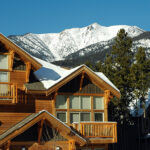Home »

Forecast says Old Man Winter sticking around
Last year at this time, most East Kootenay residents had their snow shovels put away and spring was on its way.
This year, most East Kootenay residents are wondering about possible flooding in their basements and communities as snow continues to fall, cold continues to reign and winter drags on.
 Sadly, for everyone other than winter sports nuts, we still have a way to go before spring has sprung.
Sadly, for everyone other than winter sports nuts, we still have a way to go before spring has sprung.
AccuWeather Global Weather Centre reports the cold and stormy weather pattern that has dominated Western Canada this winter will continue into the spring, providing excellent conditions for ski resorts across the region.
“The first half of the spring is expected to remain chilly and wet across British Columbia with additional opportunities for heavy snowfall in the mountains through April,” reported AccuWeather Canadian Weather Expert Brett Anderson.
Some of the stronger storms that move into the region could bring heavy rain and strong wind gusts near the coast and metres of snow to the high elevations of the Canadian Rockies.
While these storms may bring major disruptions to travel and daily routines, the snow that falls over the mountains will be beneficial for ski resorts across the region, as well as community water tables.
“Excellent spring skiing conditions are expected across [Western Canada] due to significant snowpack and sustained cold through early spring, ” Anderson said.
Even though the frequency of storms is expected to decrease during the second half of spring, the snowpack built up in the mountains should result in a longer-than-normal ski season.
While Old Man Winter is lingering like an unwelcome drunk at a tea party, many East Kootenay residents are of the opinion the region is getting record volumes of snow.
That is not the case, according to current statistics. The Cranbrook area has received 109.8 centimetres of snow so far this winter. The area had 107.2 cm last year. By far the largest snowfall year for the region was 1996, with 316.1 cm of snowfall.
Avalanche risk is also quite high at this time in the Rockies and Purcells. Make sure you check out Avalanche Canada information before venturing into the backcountry.
To the east, the changing of the seasons will bring the risk of flooding across part of the prairies, especially as temperatures rise later in the season.
“A combination of above-normal winter snowfall, unusually high river levels and the potential for ice jams will lead to a major flood risk in low-lying areas near rivers and streams from southeastern Saskatchewan into portions of northwestern Ontario,” Anderson said.
Winnipeg and Regina are among those that could be at risk for spring flooding.
A wetter-than-normal spring can exacerbate flooding issues in this region, he added.
e-KNOW







